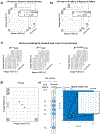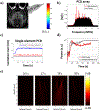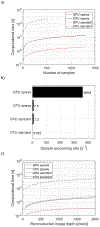Real-Time Passive Acoustic Mapping Using Sparse Matrix Multiplication
- PMID: 32746182
- PMCID: PMC7770101
- DOI: 10.1109/TUFFC.2020.3001848
Real-Time Passive Acoustic Mapping Using Sparse Matrix Multiplication
Abstract
Passive acoustic mapping enables the spatiotemporal monitoring of cavitation with circulating microbubbles during focused ultrasound (FUS)-mediated blood-brain barrier opening. However, the computational load for processing large data sets of cavitation maps or more complex algorithms limit the visualization in real-time for treatment monitoring and adjustment. In this study, we implemented a graphical processing unit (GPU)-accelerated sparse matrix-based beamforming and time exposure acoustics in a neuronavigation-guided ultrasound system for real-time spatiotemporal monitoring of cavitation. The system performance was tested in silico through benchmarking, in vitro using nonhuman primate (NHP) and human skull specimens, and demonstrated in vivo in NHPs. We demonstrated the stability of the cavitation map for integration times longer than 62.5 [Formula: see text]. A compromise between real-time displaying and cavitation map quality obtained from beamformed RF data sets with a size of 2000 ×128 ×30 (axial [Formula: see text]) was achieved for an integration time of [Formula: see text], which required a computational time of 0.27 s (frame rate of 3.7 Hz) and could be displayed in real-time between pulses at PRF = 2 Hz. Our benchmarking tests show that the GPU sparse-matrix algorithm processed the RF data set at a computational rate of [Formula: see text]/pixel/sample, which enables adjusting the frame rate and the integration time as needed. The neuronavigation system with real-time implementation of cavitation mapping facilitated the localization of the cavitation activity and helped to identify distortions due to FUS phase aberration. The in vivo test of the method demonstrated the feasibility of GPU-accelerated sparse matrix computing in a close to a clinical condition, where focus distortions exemplify problems during treatment. These experimental conditions show the need for spatiotemporal monitoring of cavitation with real-time capability that enables the operator to correct or halt the sonication in case substantial aberrations are observed.
Figures








References
-
- Hammarlund-Udenaes M, de Lange ECM, and Thorne RG, Eds., Drug Delivery to the Brain, vol. 10 New York, NY: Springer New York, 2014.
-
- Hynynen K, McDannold N, Vykhodtseva N, and a Jolesz F, “Noninvasive MR Imaging–guided Focal Opening of the Blood-Brain Barrier in Rabbits,” Radiology, vol. 220, no. 3, pp. 640–646, September 2001. - PubMed
Publication types
MeSH terms
Grants and funding
LinkOut - more resources
Full Text Sources
Other Literature Sources

